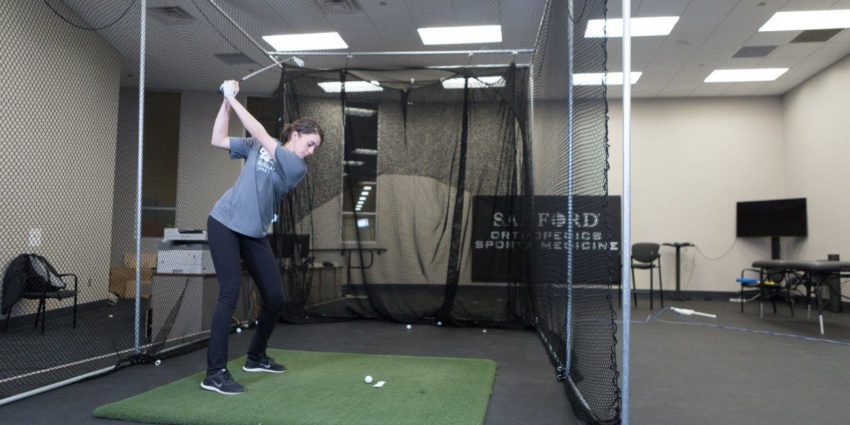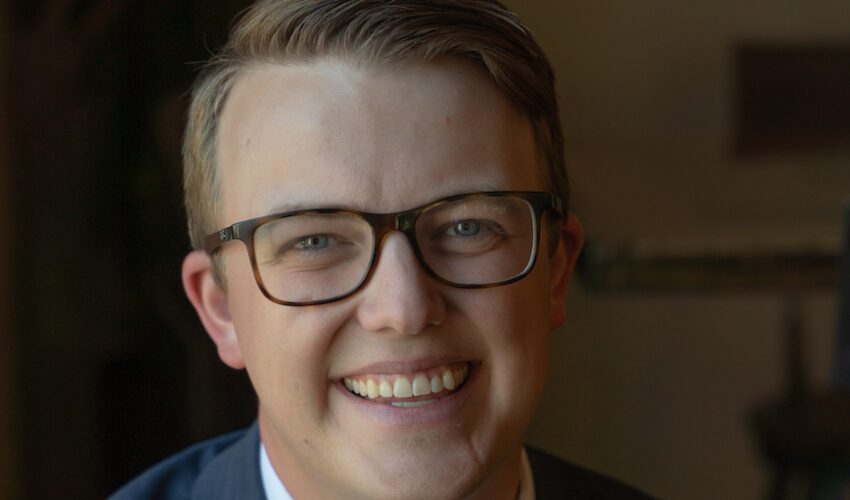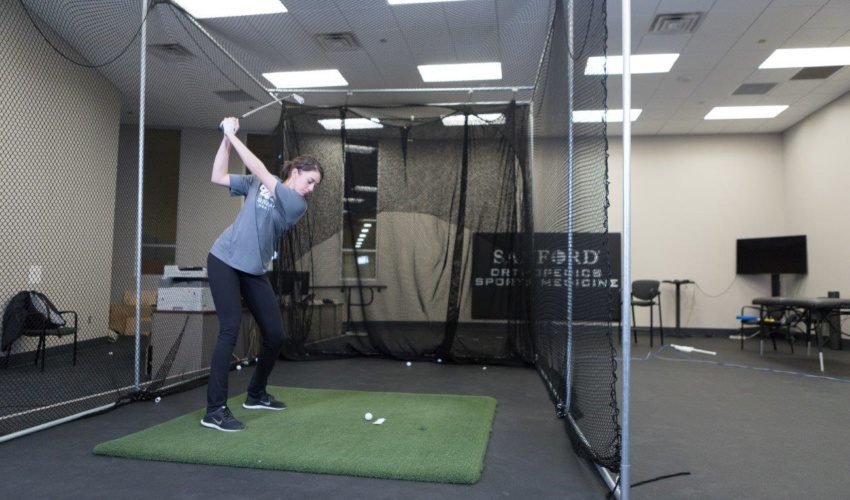High-tech approach matched with expert advice leads to big improvements for golfers
June 19, 2019
This paid piece is sponsored by Sanford Health.
Technology and golf have always had a pretty tight relationship.
Going back to when golfers decided steel was a better option than hickory for the shafts of their clubs, humans have been trying to improve their scores by improving their equipment.
It was definitely slow-moving at first – golfers used clubs with wooden shafts from the late 1400s until about 1930 — but the pace of advancements has increased considerably since then. Technological progressions boasted annually by golf companies now come at players in a blur.
There remain paradigm shifts, however, that change everything.
At the Sanford POWER Golf Academy, Todd Kolb and his team are harnessing the power of analytics involved in designing better equipment and turning it around. That is, toward the golfer.
“At Sanford, I think we’re doing something that is truly unique,” said Kolb, an award-winning teaching pro in Sioux Falls who is now the director of Sanford POWER Golf Academy.
“We’re taking the club component, the ball component and the body component, and we’re integrating them with golf instructors, physical therapists, athletic trainers, biomechanical engineers and a sports dietitian. We’re taking a holistic approach backed by our own research and development.”
At first glance, analysis from that many different experts makes becoming a better golfer sound like becoming a better astronaut. But it’s not quite that complicated.
“When I sit down as the messenger with one of our athletes, I’m taking all of the knowledge of our people and delivering a message that is concise and simple,” Kolb said. “But it’s based on something much deeper than just forming an opinion from something I saw on the video.”
The cornerstone of this approach is three-dimensional motion-capture technology – the same technology that is used for computer graphics in movies and video games – that takes a player’s swing and digitally measures it. Where is the right elbow when the club head is right here? How fast does this golfer go from this position to that position in the downswing?
The motion-capture technology is integrated with force plates – to measure how a player interacts with the ground – and ball launch monitor technology – to calculate things like club head speed, ball distance and ball spin – for a comprehensive look at the player’s swing and performance both indoors and outdoors.
“We track the movement of the body in three dimensions,” Kolb said. “The golf swing is complex and moves in multiple planes. This technology allows us to measure the things we can’t see in a video like rotation and the way the golfer is generating power from the ground.”
Ultimately, when Kolb begins those conversations with his students, the complex, behind-the-scenes work of the POWER Academy crew is likely reduced to a few sentences.
“All an athlete wants to know is ‘What do I need to do? I just want to get better. I don’t care about all the stuff that comes with it,’ ” Kolb said. “So we take the matrix of information, and we simplify it into one message for that athlete that is very simple and concise.”
It is particularly helpful in places like South Dakota where players can make targeted improvements to their games in the off-season. Usually, the winter months would involve players hitting the ball off a mat into a net with no assurances any of it was actually making them any better. A golfer could very well be doing nothing more than reinforcing bad habits.
“The technology really helps with the off-season when we can’t be outside,” said Lauren Sutcliffe, a high school golfer who will be a sophomore at O’Gorman High School and is working with Kolb. “It gives you the feel of being outside because it gives you your carry distance, roll distance, the ball speed and club speed. And it doesn’t just help the students, it helps the coaches. It tells us what we need to work on.”
When a player like Sutcliffe is choosing a club for her next shot, she knows how far the golf ball usually carries and rolls with that particular club. Verifying these numbers is a great way of building confidence. Likewise, when Kolb and his staff talk to a person about their golf swing, it’s not built on hunches. The technological information passed along is verifiable.
“You can look at a video and say ‘Well, their hips are turning too much,’ ” Kolb said. “Well, what is too much? We have a number now and it is 30 or it is 40 or whatever the number is. Now, we can track that.”
As players advance in ability, their capacity to use information becomes more refined. As such, it never ceases to be a potential resource.
“An example would be if I wasn’t hitting it well and I talked to Todd and I’d start hitting and it would tell me my club path is four degrees to the left,” said Matt Gusso, a Sanford POWER Academy student who will be a junior at Brandon Valley High School. “That means I’m coming down on the ball. For my swing, I should be four degrees to the right. Now, because of that simple number, I know I need to swing more in and out, and it will fix it.”
Sometimes that simple number steers golfers in ways that do not seem intuitive. Sometimes what you’re really doing wrong, Gusso has discovered, is not what you think.
“He definitely surprises me sometimes,” Gusso said of his conversations with Kolb. “I would never think of some of the things he tells me. And they actually work. If it was just myself, I wouldn’t have a chance because I don’t have any of that technology or the knowledge he has.”
Sanford Health’s work in improving the teaching process helped land the 10th World Scientific Congress of Golf 2021 in Sioux Falls. It will center on golf science and research, and take place at Sanford Great Shots and the Sanford Sports Science Institute Golf Research Lab located in the Sanford POWER Golf Academy at Great Shots, which is under construction.
Leaders from Sanford Health such as Lisa MacFadden, director of the Sanford Sports Science Institute, as well as Kolb and his staff, will present at the conference and share their state-of-the art lab and teaching facilities with presenters and attendees from around the world.
It is another outward sign that the work at the Academy is being recognized. The ultimate measure, however, always will be helping people play better golf.
“The golf swing in many regards is like a matrix,” Kolb said. “There are a lot of moving parts. Good coaches take a complicated situation and make it simple. But for coaches to make it simple, they have to have people behind them who take the complexity out of it. That’s where what we’re doing at Sanford is truly ground-breaking.”








